Comprehensive Case Study: Chest Pain, Nursing Care, and Mr. Deltori
VerifiedAdded on 2023/01/12
|10
|2114
|67
Case Study
AI Summary
This case study focuses on Mr. Gordon Deltori, a 68-year-old taxi driver presenting with chest pain. The study provides an overview of his condition, including his medical history of hypertension, atrial fibrillation, and type 2 diabetes, as well as his current symptoms and risk factors like smoking and unhealthy diet. The assignment delves into the patient's presenting problems, specifically focusing on the pathophysiological issues related to his chest pain. It identifies and discusses the care priorities for Mr. Deltori, emphasizing the use of the Levitt-Jones' Clinical Reasoning Cycle to justify the first two nursing care priorities, such as stroke risk screening and dietary changes, supported by relevant literature. Furthermore, the study explains the pharmacokinetics of two medications, Apixaban and Anginine, that Mr. Deltori is taking, highlighting their roles in his treatment. The conclusion emphasizes the importance of nursing care plans and interventions in improving patient health outcomes, particularly in cases of stroke and heart-related problems. The case study aims to provide a comprehensive analysis of Mr. Deltori's condition and the nursing interventions required to manage his health issues effectively.
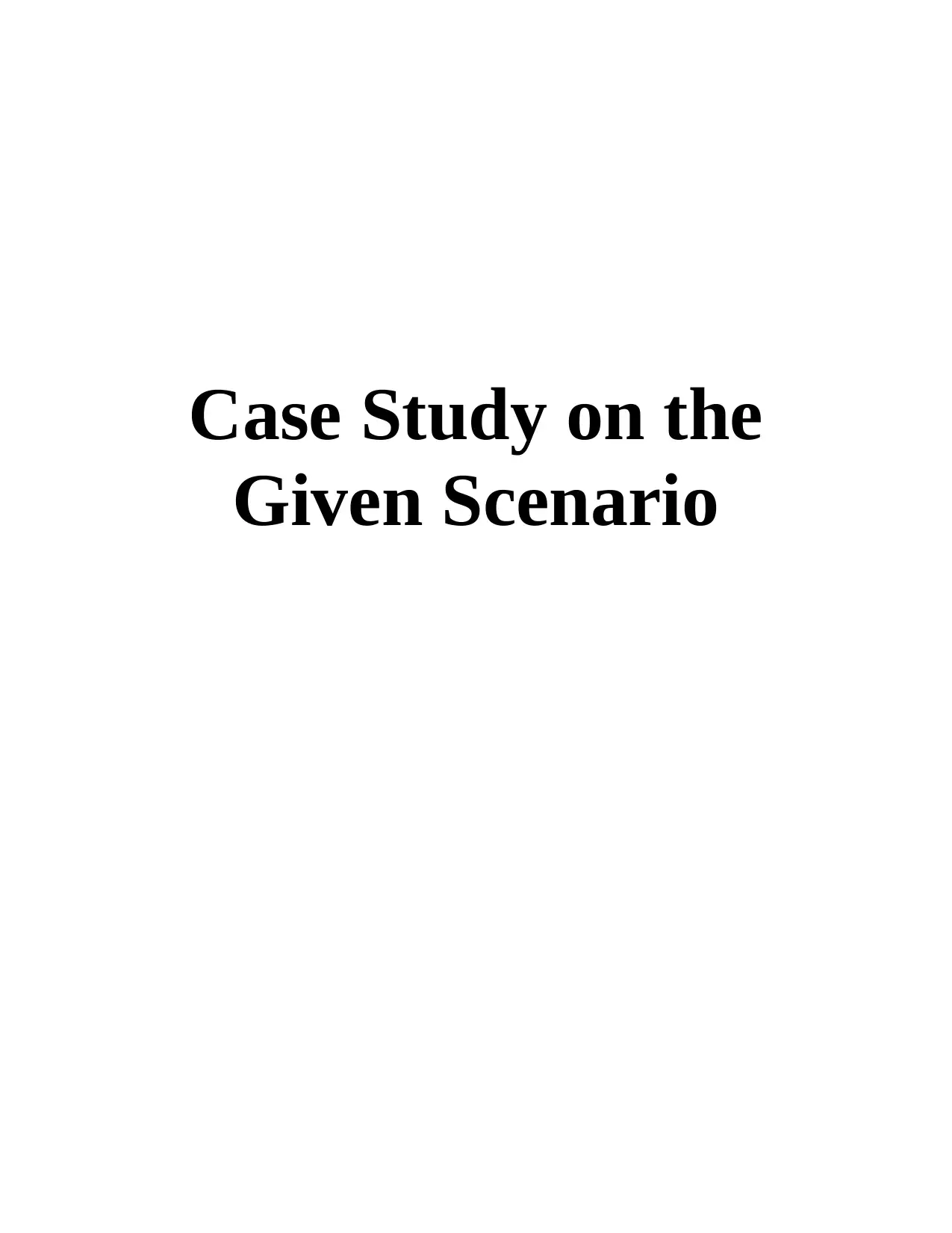
Case Study on the
Given Scenario
Given Scenario
Paraphrase This Document
Need a fresh take? Get an instant paraphrase of this document with our AI Paraphraser
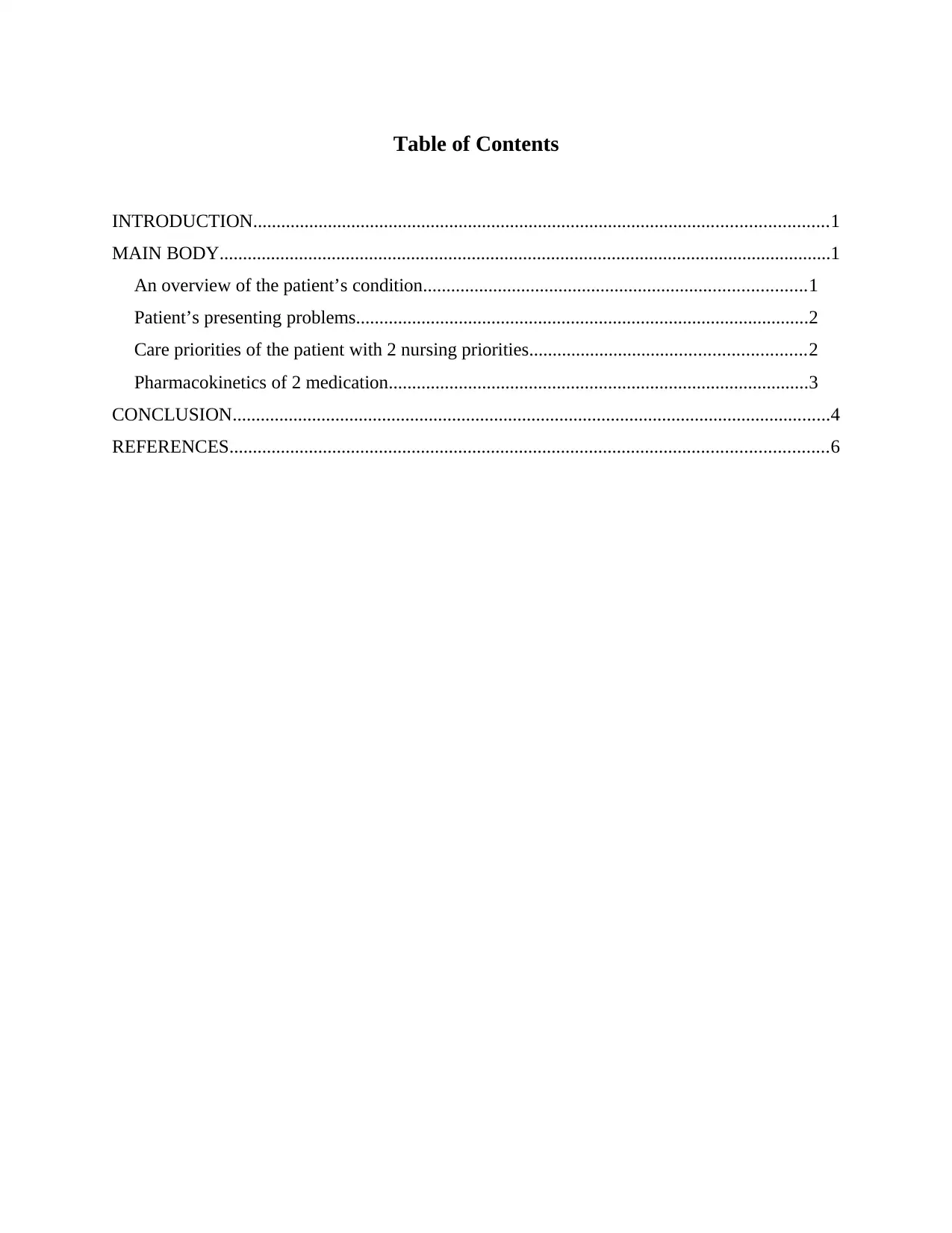
Table of Contents
INTRODUCTION...........................................................................................................................1
MAIN BODY...................................................................................................................................1
An overview of the patient’s condition..................................................................................1
Patient’s presenting problems.................................................................................................2
Care priorities of the patient with 2 nursing priorities...........................................................2
Pharmacokinetics of 2 medication..........................................................................................3
CONCLUSION................................................................................................................................4
REFERENCES................................................................................................................................6
INTRODUCTION...........................................................................................................................1
MAIN BODY...................................................................................................................................1
An overview of the patient’s condition..................................................................................1
Patient’s presenting problems.................................................................................................2
Care priorities of the patient with 2 nursing priorities...........................................................2
Pharmacokinetics of 2 medication..........................................................................................3
CONCLUSION................................................................................................................................4
REFERENCES................................................................................................................................6
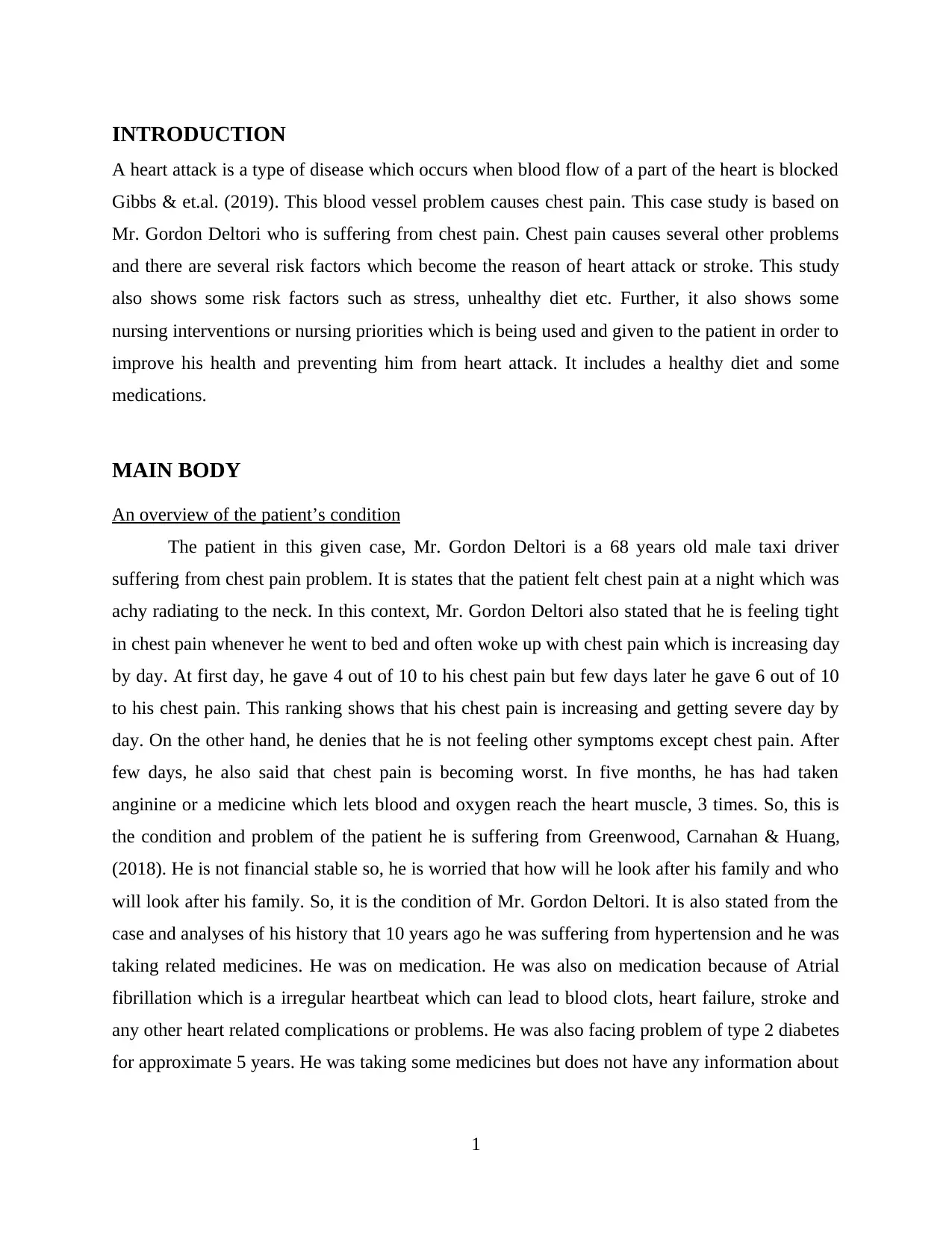
INTRODUCTION
A heart attack is a type of disease which occurs when blood flow of a part of the heart is blocked
Gibbs & et.al. (2019). This blood vessel problem causes chest pain. This case study is based on
Mr. Gordon Deltori who is suffering from chest pain. Chest pain causes several other problems
and there are several risk factors which become the reason of heart attack or stroke. This study
also shows some risk factors such as stress, unhealthy diet etc. Further, it also shows some
nursing interventions or nursing priorities which is being used and given to the patient in order to
improve his health and preventing him from heart attack. It includes a healthy diet and some
medications.
MAIN BODY
An overview of the patient’s condition
The patient in this given case, Mr. Gordon Deltori is a 68 years old male taxi driver
suffering from chest pain problem. It is states that the patient felt chest pain at a night which was
achy radiating to the neck. In this context, Mr. Gordon Deltori also stated that he is feeling tight
in chest pain whenever he went to bed and often woke up with chest pain which is increasing day
by day. At first day, he gave 4 out of 10 to his chest pain but few days later he gave 6 out of 10
to his chest pain. This ranking shows that his chest pain is increasing and getting severe day by
day. On the other hand, he denies that he is not feeling other symptoms except chest pain. After
few days, he also said that chest pain is becoming worst. In five months, he has had taken
anginine or a medicine which lets blood and oxygen reach the heart muscle, 3 times. So, this is
the condition and problem of the patient he is suffering from Greenwood, Carnahan & Huang,
(2018). He is not financial stable so, he is worried that how will he look after his family and who
will look after his family. So, it is the condition of Mr. Gordon Deltori. It is also stated from the
case and analyses of his history that 10 years ago he was suffering from hypertension and he was
taking related medicines. He was on medication. He was also on medication because of Atrial
fibrillation which is a irregular heartbeat which can lead to blood clots, heart failure, stroke and
any other heart related complications or problems. He was also facing problem of type 2 diabetes
for approximate 5 years. He was taking some medicines but does not have any information about
1
A heart attack is a type of disease which occurs when blood flow of a part of the heart is blocked
Gibbs & et.al. (2019). This blood vessel problem causes chest pain. This case study is based on
Mr. Gordon Deltori who is suffering from chest pain. Chest pain causes several other problems
and there are several risk factors which become the reason of heart attack or stroke. This study
also shows some risk factors such as stress, unhealthy diet etc. Further, it also shows some
nursing interventions or nursing priorities which is being used and given to the patient in order to
improve his health and preventing him from heart attack. It includes a healthy diet and some
medications.
MAIN BODY
An overview of the patient’s condition
The patient in this given case, Mr. Gordon Deltori is a 68 years old male taxi driver
suffering from chest pain problem. It is states that the patient felt chest pain at a night which was
achy radiating to the neck. In this context, Mr. Gordon Deltori also stated that he is feeling tight
in chest pain whenever he went to bed and often woke up with chest pain which is increasing day
by day. At first day, he gave 4 out of 10 to his chest pain but few days later he gave 6 out of 10
to his chest pain. This ranking shows that his chest pain is increasing and getting severe day by
day. On the other hand, he denies that he is not feeling other symptoms except chest pain. After
few days, he also said that chest pain is becoming worst. In five months, he has had taken
anginine or a medicine which lets blood and oxygen reach the heart muscle, 3 times. So, this is
the condition and problem of the patient he is suffering from Greenwood, Carnahan & Huang,
(2018). He is not financial stable so, he is worried that how will he look after his family and who
will look after his family. So, it is the condition of Mr. Gordon Deltori. It is also stated from the
case and analyses of his history that 10 years ago he was suffering from hypertension and he was
taking related medicines. He was on medication. He was also on medication because of Atrial
fibrillation which is a irregular heartbeat which can lead to blood clots, heart failure, stroke and
any other heart related complications or problems. He was also facing problem of type 2 diabetes
for approximate 5 years. He was taking some medicines but does not have any information about
1
⊘ This is a preview!⊘
Do you want full access?
Subscribe today to unlock all pages.

Trusted by 1+ million students worldwide
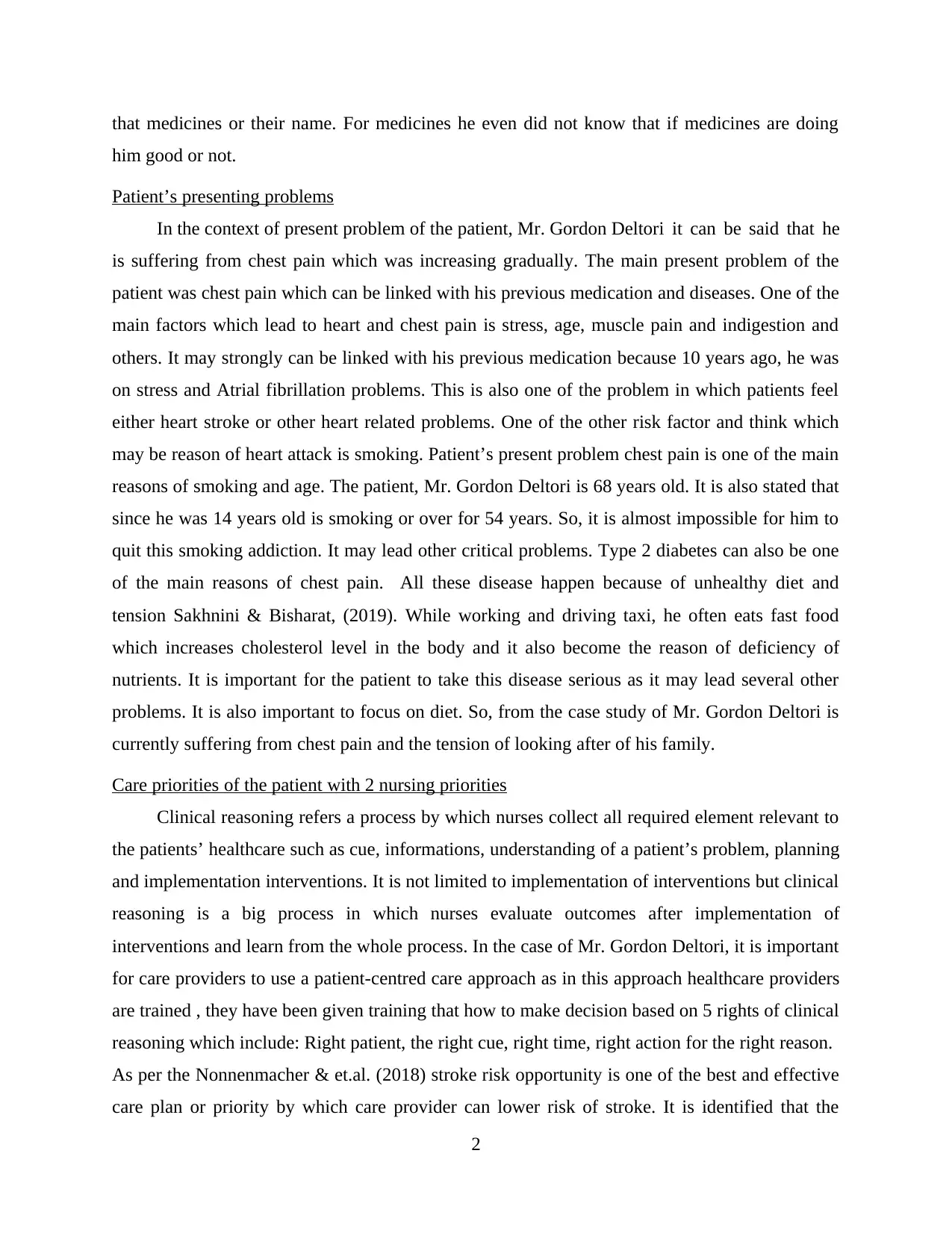
that medicines or their name. For medicines he even did not know that if medicines are doing
him good or not.
Patient’s presenting problems
In the context of present problem of the patient, Mr. Gordon Deltori it can be said that he
is suffering from chest pain which was increasing gradually. The main present problem of the
patient was chest pain which can be linked with his previous medication and diseases. One of the
main factors which lead to heart and chest pain is stress, age, muscle pain and indigestion and
others. It may strongly can be linked with his previous medication because 10 years ago, he was
on stress and Atrial fibrillation problems. This is also one of the problem in which patients feel
either heart stroke or other heart related problems. One of the other risk factor and think which
may be reason of heart attack is smoking. Patient’s present problem chest pain is one of the main
reasons of smoking and age. The patient, Mr. Gordon Deltori is 68 years old. It is also stated that
since he was 14 years old is smoking or over for 54 years. So, it is almost impossible for him to
quit this smoking addiction. It may lead other critical problems. Type 2 diabetes can also be one
of the main reasons of chest pain. All these disease happen because of unhealthy diet and
tension Sakhnini & Bisharat, (2019). While working and driving taxi, he often eats fast food
which increases cholesterol level in the body and it also become the reason of deficiency of
nutrients. It is important for the patient to take this disease serious as it may lead several other
problems. It is also important to focus on diet. So, from the case study of Mr. Gordon Deltori is
currently suffering from chest pain and the tension of looking after of his family.
Care priorities of the patient with 2 nursing priorities
Clinical reasoning refers a process by which nurses collect all required element relevant to
the patients’ healthcare such as cue, informations, understanding of a patient’s problem, planning
and implementation interventions. It is not limited to implementation of interventions but clinical
reasoning is a big process in which nurses evaluate outcomes after implementation of
interventions and learn from the whole process. In the case of Mr. Gordon Deltori, it is important
for care providers to use a patient-centred care approach as in this approach healthcare providers
are trained , they have been given training that how to make decision based on 5 rights of clinical
reasoning which include: Right patient, the right cue, right time, right action for the right reason.
As per the Nonnenmacher & et.al. (2018) stroke risk opportunity is one of the best and effective
care plan or priority by which care provider can lower risk of stroke. It is identified that the
2
him good or not.
Patient’s presenting problems
In the context of present problem of the patient, Mr. Gordon Deltori it can be said that he
is suffering from chest pain which was increasing gradually. The main present problem of the
patient was chest pain which can be linked with his previous medication and diseases. One of the
main factors which lead to heart and chest pain is stress, age, muscle pain and indigestion and
others. It may strongly can be linked with his previous medication because 10 years ago, he was
on stress and Atrial fibrillation problems. This is also one of the problem in which patients feel
either heart stroke or other heart related problems. One of the other risk factor and think which
may be reason of heart attack is smoking. Patient’s present problem chest pain is one of the main
reasons of smoking and age. The patient, Mr. Gordon Deltori is 68 years old. It is also stated that
since he was 14 years old is smoking or over for 54 years. So, it is almost impossible for him to
quit this smoking addiction. It may lead other critical problems. Type 2 diabetes can also be one
of the main reasons of chest pain. All these disease happen because of unhealthy diet and
tension Sakhnini & Bisharat, (2019). While working and driving taxi, he often eats fast food
which increases cholesterol level in the body and it also become the reason of deficiency of
nutrients. It is important for the patient to take this disease serious as it may lead several other
problems. It is also important to focus on diet. So, from the case study of Mr. Gordon Deltori is
currently suffering from chest pain and the tension of looking after of his family.
Care priorities of the patient with 2 nursing priorities
Clinical reasoning refers a process by which nurses collect all required element relevant to
the patients’ healthcare such as cue, informations, understanding of a patient’s problem, planning
and implementation interventions. It is not limited to implementation of interventions but clinical
reasoning is a big process in which nurses evaluate outcomes after implementation of
interventions and learn from the whole process. In the case of Mr. Gordon Deltori, it is important
for care providers to use a patient-centred care approach as in this approach healthcare providers
are trained , they have been given training that how to make decision based on 5 rights of clinical
reasoning which include: Right patient, the right cue, right time, right action for the right reason.
As per the Nonnenmacher & et.al. (2018) stroke risk opportunity is one of the best and effective
care plan or priority by which care provider can lower risk of stroke. It is identified that the
2
Paraphrase This Document
Need a fresh take? Get an instant paraphrase of this document with our AI Paraphraser
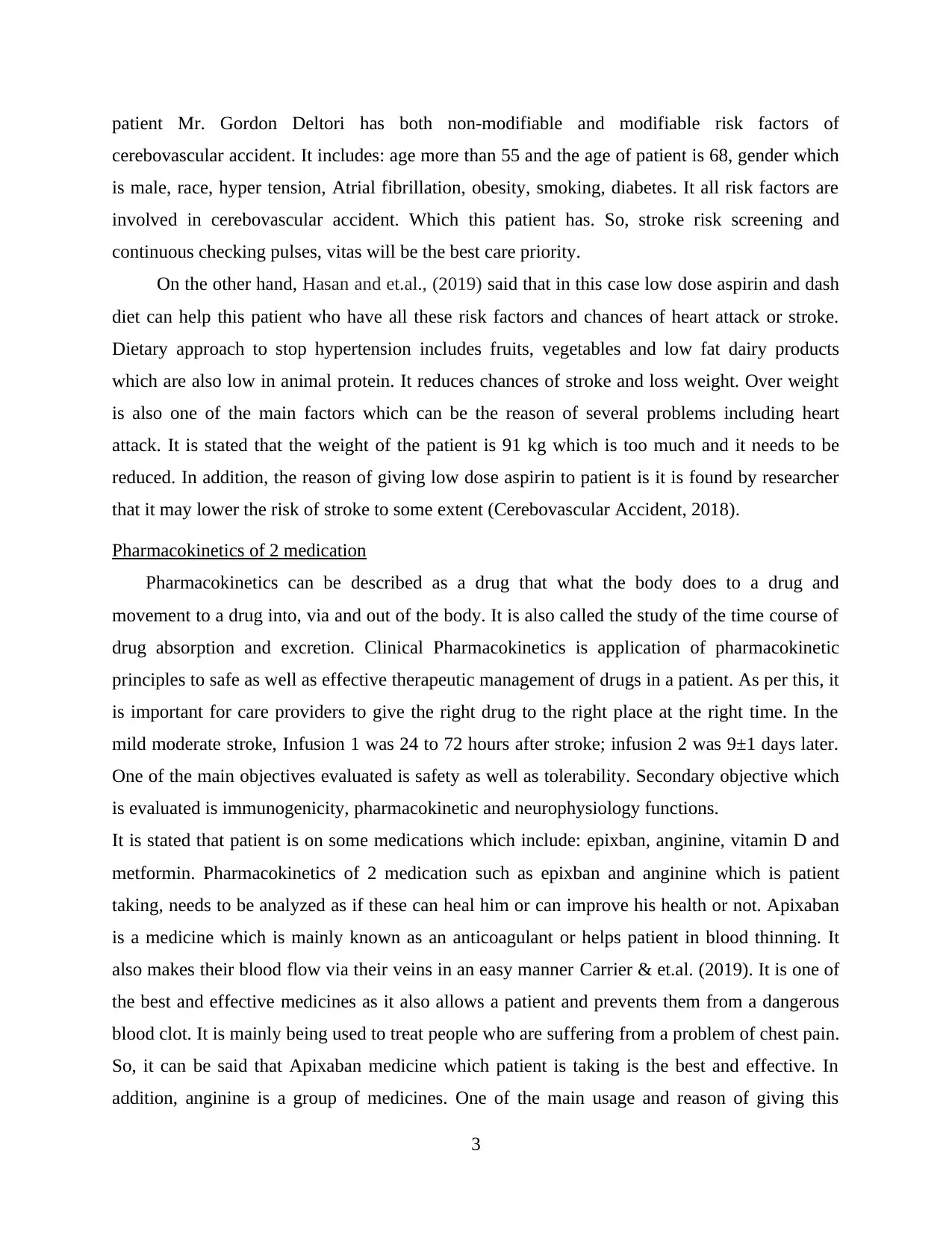
patient Mr. Gordon Deltori has both non-modifiable and modifiable risk factors of
cerebovascular accident. It includes: age more than 55 and the age of patient is 68, gender which
is male, race, hyper tension, Atrial fibrillation, obesity, smoking, diabetes. It all risk factors are
involved in cerebovascular accident. Which this patient has. So, stroke risk screening and
continuous checking pulses, vitas will be the best care priority.
On the other hand, Hasan and et.al., (2019) said that in this case low dose aspirin and dash
diet can help this patient who have all these risk factors and chances of heart attack or stroke.
Dietary approach to stop hypertension includes fruits, vegetables and low fat dairy products
which are also low in animal protein. It reduces chances of stroke and loss weight. Over weight
is also one of the main factors which can be the reason of several problems including heart
attack. It is stated that the weight of the patient is 91 kg which is too much and it needs to be
reduced. In addition, the reason of giving low dose aspirin to patient is it is found by researcher
that it may lower the risk of stroke to some extent (Cerebovascular Accident, 2018).
Pharmacokinetics of 2 medication
Pharmacokinetics can be described as a drug that what the body does to a drug and
movement to a drug into, via and out of the body. It is also called the study of the time course of
drug absorption and excretion. Clinical Pharmacokinetics is application of pharmacokinetic
principles to safe as well as effective therapeutic management of drugs in a patient. As per this, it
is important for care providers to give the right drug to the right place at the right time. In the
mild moderate stroke, Infusion 1 was 24 to 72 hours after stroke; infusion 2 was 9±1 days later.
One of the main objectives evaluated is safety as well as tolerability. Secondary objective which
is evaluated is immunogenicity, pharmacokinetic and neurophysiology functions.
It is stated that patient is on some medications which include: epixban, anginine, vitamin D and
metformin. Pharmacokinetics of 2 medication such as epixban and anginine which is patient
taking, needs to be analyzed as if these can heal him or can improve his health or not. Apixaban
is a medicine which is mainly known as an anticoagulant or helps patient in blood thinning. It
also makes their blood flow via their veins in an easy manner Carrier & et.al. (2019). It is one of
the best and effective medicines as it also allows a patient and prevents them from a dangerous
blood clot. It is mainly being used to treat people who are suffering from a problem of chest pain.
So, it can be said that Apixaban medicine which patient is taking is the best and effective. In
addition, anginine is a group of medicines. One of the main usage and reason of giving this
3
cerebovascular accident. It includes: age more than 55 and the age of patient is 68, gender which
is male, race, hyper tension, Atrial fibrillation, obesity, smoking, diabetes. It all risk factors are
involved in cerebovascular accident. Which this patient has. So, stroke risk screening and
continuous checking pulses, vitas will be the best care priority.
On the other hand, Hasan and et.al., (2019) said that in this case low dose aspirin and dash
diet can help this patient who have all these risk factors and chances of heart attack or stroke.
Dietary approach to stop hypertension includes fruits, vegetables and low fat dairy products
which are also low in animal protein. It reduces chances of stroke and loss weight. Over weight
is also one of the main factors which can be the reason of several problems including heart
attack. It is stated that the weight of the patient is 91 kg which is too much and it needs to be
reduced. In addition, the reason of giving low dose aspirin to patient is it is found by researcher
that it may lower the risk of stroke to some extent (Cerebovascular Accident, 2018).
Pharmacokinetics of 2 medication
Pharmacokinetics can be described as a drug that what the body does to a drug and
movement to a drug into, via and out of the body. It is also called the study of the time course of
drug absorption and excretion. Clinical Pharmacokinetics is application of pharmacokinetic
principles to safe as well as effective therapeutic management of drugs in a patient. As per this, it
is important for care providers to give the right drug to the right place at the right time. In the
mild moderate stroke, Infusion 1 was 24 to 72 hours after stroke; infusion 2 was 9±1 days later.
One of the main objectives evaluated is safety as well as tolerability. Secondary objective which
is evaluated is immunogenicity, pharmacokinetic and neurophysiology functions.
It is stated that patient is on some medications which include: epixban, anginine, vitamin D and
metformin. Pharmacokinetics of 2 medication such as epixban and anginine which is patient
taking, needs to be analyzed as if these can heal him or can improve his health or not. Apixaban
is a medicine which is mainly known as an anticoagulant or helps patient in blood thinning. It
also makes their blood flow via their veins in an easy manner Carrier & et.al. (2019). It is one of
the best and effective medicines as it also allows a patient and prevents them from a dangerous
blood clot. It is mainly being used to treat people who are suffering from a problem of chest pain.
So, it can be said that Apixaban medicine which patient is taking is the best and effective. In
addition, anginine is a group of medicines. One of the main usage and reason of giving this
3
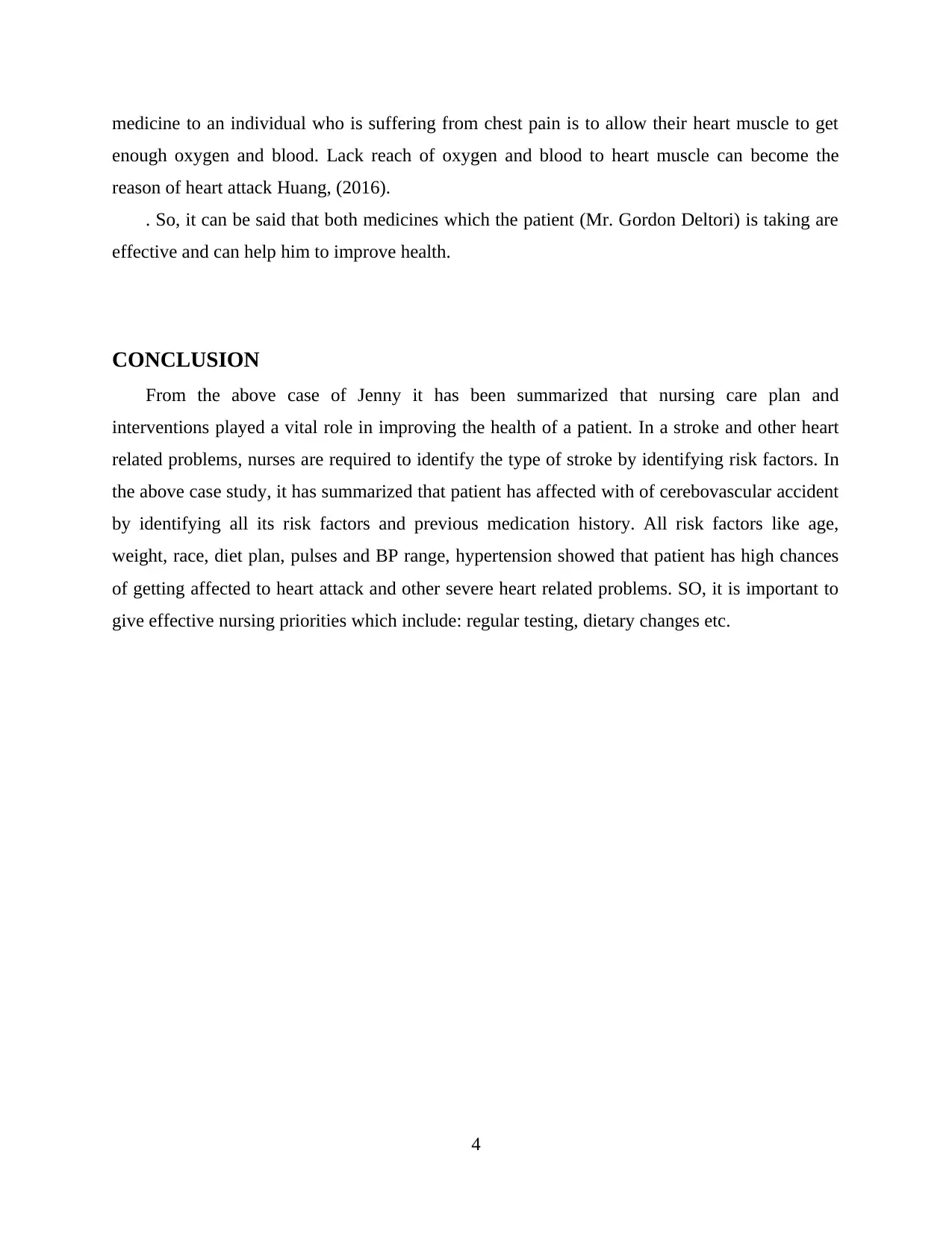
medicine to an individual who is suffering from chest pain is to allow their heart muscle to get
enough oxygen and blood. Lack reach of oxygen and blood to heart muscle can become the
reason of heart attack Huang, (2016).
. So, it can be said that both medicines which the patient (Mr. Gordon Deltori) is taking are
effective and can help him to improve health.
CONCLUSION
From the above case of Jenny it has been summarized that nursing care plan and
interventions played a vital role in improving the health of a patient. In a stroke and other heart
related problems, nurses are required to identify the type of stroke by identifying risk factors. In
the above case study, it has summarized that patient has affected with of cerebovascular accident
by identifying all its risk factors and previous medication history. All risk factors like age,
weight, race, diet plan, pulses and BP range, hypertension showed that patient has high chances
of getting affected to heart attack and other severe heart related problems. SO, it is important to
give effective nursing priorities which include: regular testing, dietary changes etc.
4
enough oxygen and blood. Lack reach of oxygen and blood to heart muscle can become the
reason of heart attack Huang, (2016).
. So, it can be said that both medicines which the patient (Mr. Gordon Deltori) is taking are
effective and can help him to improve health.
CONCLUSION
From the above case of Jenny it has been summarized that nursing care plan and
interventions played a vital role in improving the health of a patient. In a stroke and other heart
related problems, nurses are required to identify the type of stroke by identifying risk factors. In
the above case study, it has summarized that patient has affected with of cerebovascular accident
by identifying all its risk factors and previous medication history. All risk factors like age,
weight, race, diet plan, pulses and BP range, hypertension showed that patient has high chances
of getting affected to heart attack and other severe heart related problems. SO, it is important to
give effective nursing priorities which include: regular testing, dietary changes etc.
4
⊘ This is a preview!⊘
Do you want full access?
Subscribe today to unlock all pages.

Trusted by 1+ million students worldwide

5
Paraphrase This Document
Need a fresh take? Get an instant paraphrase of this document with our AI Paraphraser
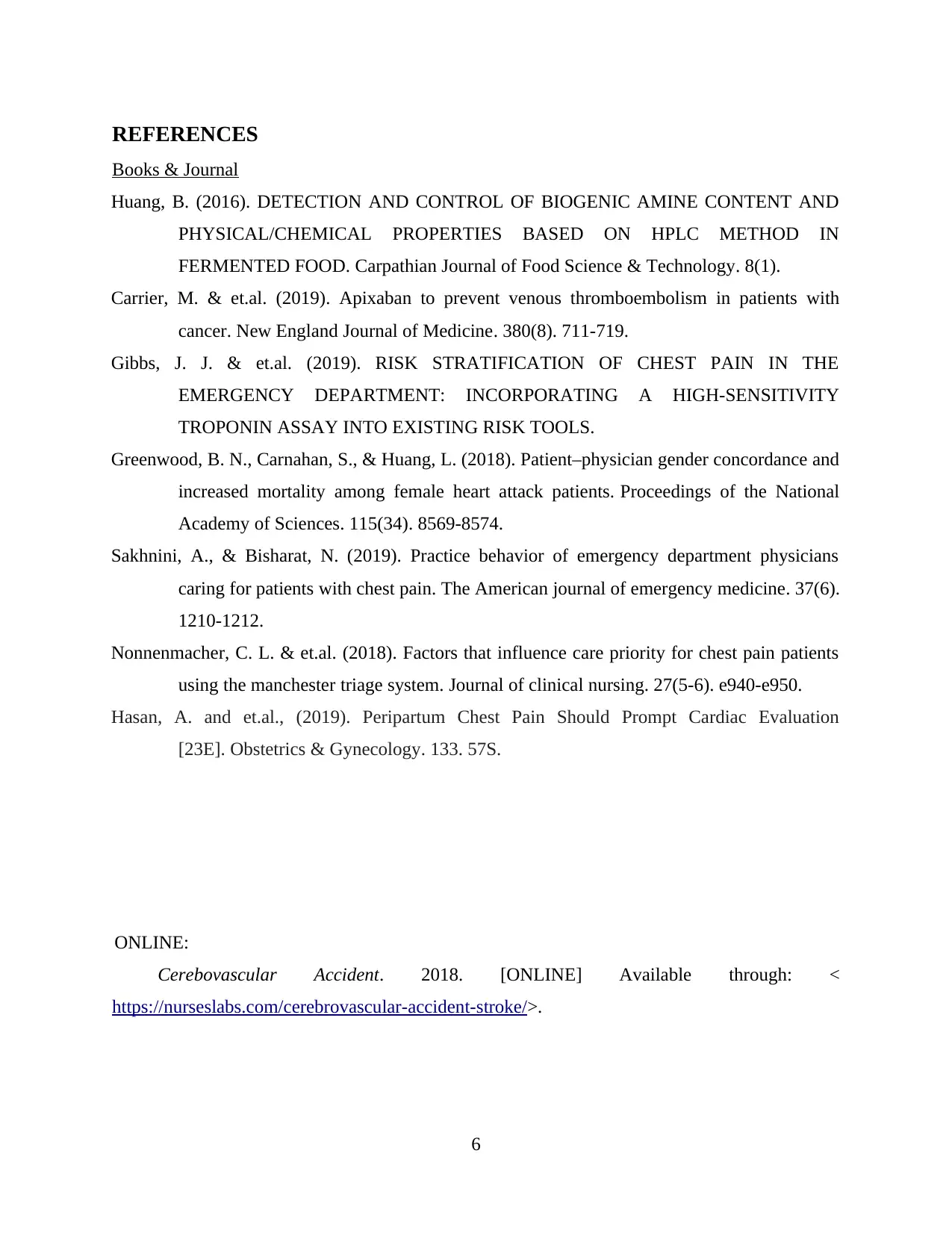
REFERENCES
Books & Journal
Huang, B. (2016). DETECTION AND CONTROL OF BIOGENIC AMINE CONTENT AND
PHYSICAL/CHEMICAL PROPERTIES BASED ON HPLC METHOD IN
FERMENTED FOOD. Carpathian Journal of Food Science & Technology. 8(1).
Carrier, M. & et.al. (2019). Apixaban to prevent venous thromboembolism in patients with
cancer. New England Journal of Medicine. 380(8). 711-719.
Gibbs, J. J. & et.al. (2019). RISK STRATIFICATION OF CHEST PAIN IN THE
EMERGENCY DEPARTMENT: INCORPORATING A HIGH-SENSITIVITY
TROPONIN ASSAY INTO EXISTING RISK TOOLS.
Greenwood, B. N., Carnahan, S., & Huang, L. (2018). Patient–physician gender concordance and
increased mortality among female heart attack patients. Proceedings of the National
Academy of Sciences. 115(34). 8569-8574.
Sakhnini, A., & Bisharat, N. (2019). Practice behavior of emergency department physicians
caring for patients with chest pain. The American journal of emergency medicine. 37(6).
1210-1212.
Nonnenmacher, C. L. & et.al. (2018). Factors that influence care priority for chest pain patients
using the manchester triage system. Journal of clinical nursing. 27(5-6). e940-e950.
Hasan, A. and et.al., (2019). Peripartum Chest Pain Should Prompt Cardiac Evaluation
[23E]. Obstetrics & Gynecology. 133. 57S.
ONLINE:
Cerebovascular Accident. 2018. [ONLINE] Available through: <
https://nurseslabs.com/cerebrovascular-accident-stroke/>.
6
Books & Journal
Huang, B. (2016). DETECTION AND CONTROL OF BIOGENIC AMINE CONTENT AND
PHYSICAL/CHEMICAL PROPERTIES BASED ON HPLC METHOD IN
FERMENTED FOOD. Carpathian Journal of Food Science & Technology. 8(1).
Carrier, M. & et.al. (2019). Apixaban to prevent venous thromboembolism in patients with
cancer. New England Journal of Medicine. 380(8). 711-719.
Gibbs, J. J. & et.al. (2019). RISK STRATIFICATION OF CHEST PAIN IN THE
EMERGENCY DEPARTMENT: INCORPORATING A HIGH-SENSITIVITY
TROPONIN ASSAY INTO EXISTING RISK TOOLS.
Greenwood, B. N., Carnahan, S., & Huang, L. (2018). Patient–physician gender concordance and
increased mortality among female heart attack patients. Proceedings of the National
Academy of Sciences. 115(34). 8569-8574.
Sakhnini, A., & Bisharat, N. (2019). Practice behavior of emergency department physicians
caring for patients with chest pain. The American journal of emergency medicine. 37(6).
1210-1212.
Nonnenmacher, C. L. & et.al. (2018). Factors that influence care priority for chest pain patients
using the manchester triage system. Journal of clinical nursing. 27(5-6). e940-e950.
Hasan, A. and et.al., (2019). Peripartum Chest Pain Should Prompt Cardiac Evaluation
[23E]. Obstetrics & Gynecology. 133. 57S.
ONLINE:
Cerebovascular Accident. 2018. [ONLINE] Available through: <
https://nurseslabs.com/cerebrovascular-accident-stroke/>.
6

⊘ This is a preview!⊘
Do you want full access?
Subscribe today to unlock all pages.

Trusted by 1+ million students worldwide

1
1 out of 10
Related Documents
Your All-in-One AI-Powered Toolkit for Academic Success.
+13062052269
info@desklib.com
Available 24*7 on WhatsApp / Email
![[object Object]](/_next/static/media/star-bottom.7253800d.svg)
Unlock your academic potential
Copyright © 2020–2025 A2Z Services. All Rights Reserved. Developed and managed by ZUCOL.





